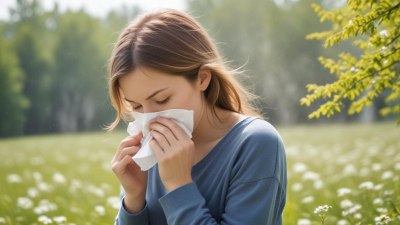The Relationship Between Weather and Allergies
Explore how weather changes impact allergy symptoms and triggers. Discover tips for managing allergies in various weather conditions.

This image was created with the assistance of Freepik
Understanding the relationship between weather and allergies is crucial for those who suffer from allergic reactions. Weather patterns can significantly influence the presence of allergens in the air, making it essential for allergy sufferers to stay informed about meteorological changes. In this article, we will examine how different weather conditions such as temperature, humidity, and wind affect allergens and, consequently, allergy symptoms.
How Weather Affects Allergens
Allergens are substances that can cause allergic reactions, and their prevalence can vary greatly with changes in the weather. For instance, pollen is a well-known allergen that is produced by trees, grasses, and weeds. The production and release of pollen are highly dependent on weather conditions. Warmer temperatures generally lead to earlier and more intense pollen seasons. In many regions, trees start to pollinate in late winter or early spring, but these timelines can shift with unseasonably warm weather.
Humidity levels also play a critical role in the dispersal of pollen. High humidity can cause pollen grains to swell and become heavier, which may reduce their ability to become airborne. Conversely, dry conditions can allow pollen to remain suspended in the air, which can exacerbate allergic reactions for those sensitive to it. Therefore, individuals with pollen allergies should pay close attention to humidity levels when planning outdoor activities.
Temperature and Allergy Symptoms
Temperature fluctuations can lead to variable reactions among those who suffer from allergies. Warmer temperatures can lead to an increase in the growth of mold, another common allergen. Mold thrives in damp environments, and higher temperatures can result in increased moisture in the air, making it conducive for mold spores to flourish. Mold allergies often peak during the warm and humid months, especially in places where heavy rainfall occurs.
Moreover, warm weather can lead to an earlier onset of ragweed pollen season, which is particularly problematic for many allergy sufferers in the late summer and fall. Ragweed plants tend to release pollen when temperatures rise, and the duration of the pollen season can extend if the fall remains warmer than usual.
Wind and Allergens
Wind can significantly affect the distribution of allergens in the environment. On blustery days, pollen can be transported long distances from its source, meaning that people may experience allergic reactions even if they are not near plants that produce pollen. Wind can also stir up dust and mold from the ground, aggravating symptoms for individuals with dust or mold allergies. As a result, windy weather can lead to increased allergy symptoms due to the sheer volume of allergens being airborne.
Managing Allergies in Different Weather Conditions
Given the undeniable link between weather and allergies, it is essential to take proactive measures to manage symptoms effectively. During high pollen seasons, it is wise to stay indoors on windy days or when the pollen count is particularly high. Many weather apps now provide pollen counts, which can help individuals plan their outdoor activities wisely.
Humidity control is also critical for those who suffer from mold allergies. Using dehumidifiers in damp areas of the home, such as basements, can significantly reduce mold growth. Moreover, ensuring proper ventilation in bathrooms and kitchens can further limit moisture levels, creating an inhospitable environment for mold.
Seasonal Considerations for Allergy Sufferers
Different seasons bring varying allergens based on the plants and weather conditions present. Spring is notorious for tree pollen, particularly from oak, birch, and cedar trees. Summer ushers in grass pollen, while late summer through fall is primarily ragweed season. Understanding the seasonal patterns of allergens can help individuals prepare and manage their symptoms.
Localized Weather Impacts
It is also important to acknowledge that localized weather conditions can impact allergy levels. For example, urban areas may experience higher levels of air pollution paired with pollen, exacerbating allergic reactions. In contrast, rural settings may see less air pollution but varying types of pollen based on vegetation. Hence, it is essential to be aware of environmental changes when considering allergy triggers.
The Role of Climate Change
Recent studies indicate that climate change is influencing the severity and duration of allergy seasons. Rising global temperatures can lead to longer growing seasons for many plants, increasing the production of pollen. Additionally, changing precipitation patterns can contribute to the growth of mold and other allergens. It is pivotal for researchers and healthcare professionals to study these trends to prepare for potential impacts on public health.
Preparation is Key
For those who are allergic, taking preventative measures ahead of allergy season can significantly mitigate symptoms. Consider scheduling an appointment with an allergy specialist to discuss options for treatment and management, which may include antihistamines, nasal sprays, or allergy shots. Medications are often most effective when started before the pollen season begins.
Additionally, implementing lifestyle changes can provide relief. Keeping windows closed during peak pollen seasons, using air purifiers, and regularly cleaning filters and ducts can reduce indoor allergen exposure.
In conclusion, the relationship between weather and allergies is complex and varies significantly with changing conditions. Temperature, humidity, and wind all contribute to the levels of allergens in the air and therefore have a direct impact on allergy sufferers. By being aware of weather patterns and seasonal changes, individuals can take steps to manage their allergy symptoms more effectively. As our climate continues to change, attention to these factors will be increasingly important for everyone's health and well-being.











